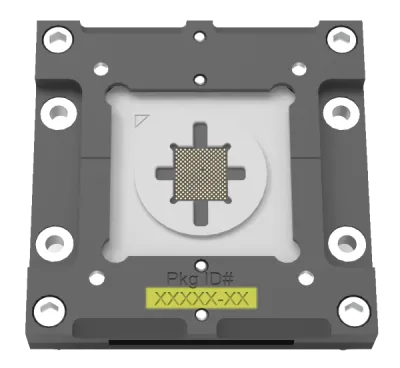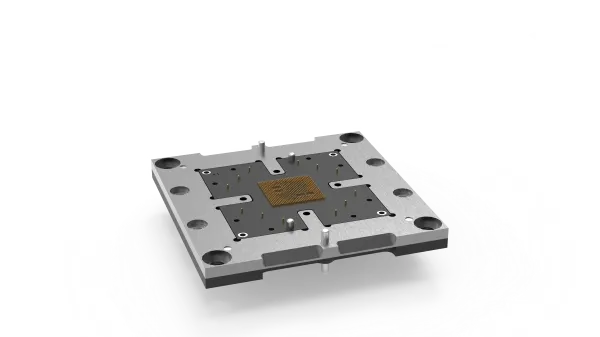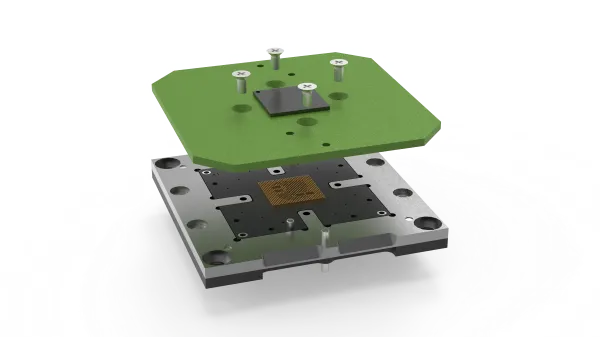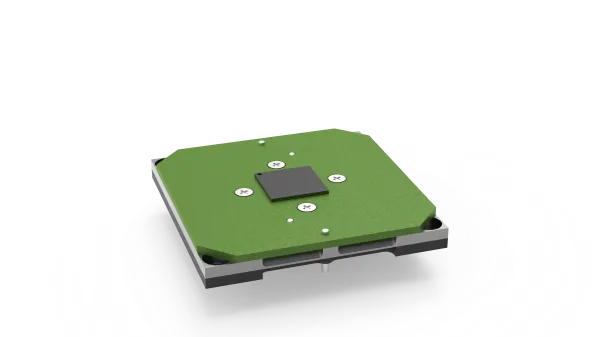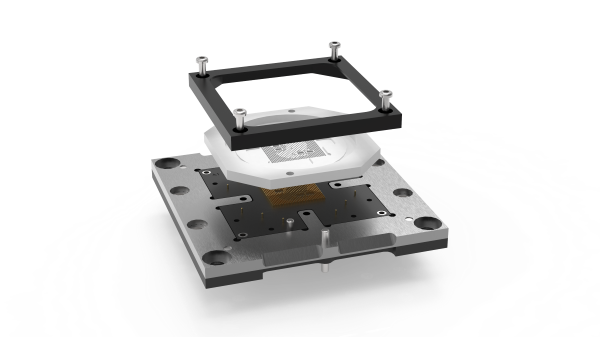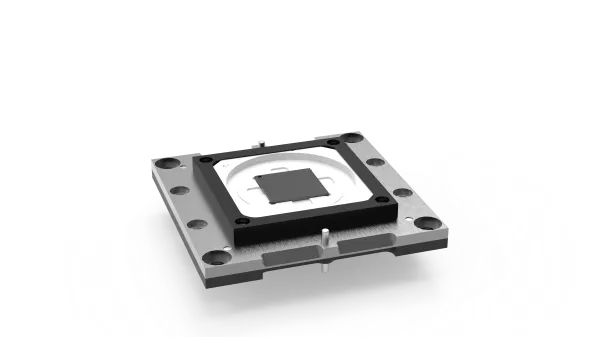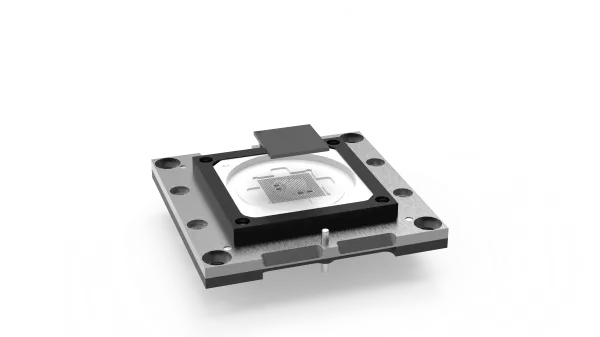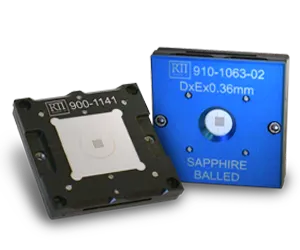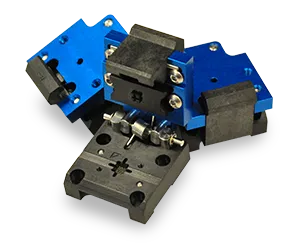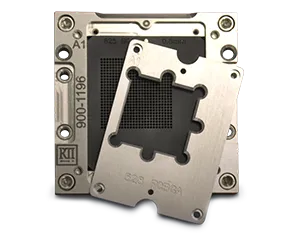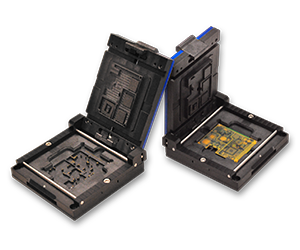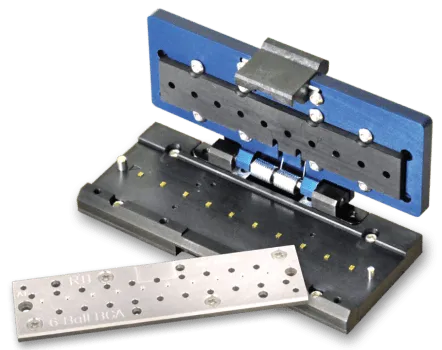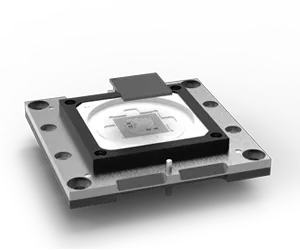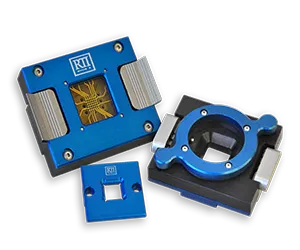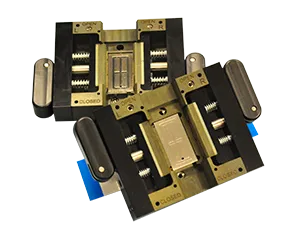Die-Level Test Sockets with Conversion Kit
SIL and EMMI Inspection, Electrical Test, and Hand Test Without Changing Hardware
RTI's die-level test sockets are designed for failure analysis, hand test applications, and advanced inspection techniques such as SIL and EMMI. With an open top design for direct device access, these sockets support DUTs reflowed onto PCB coupon boards with ease.
Quickly switch between inspection and electrical test using a simple conversion kit. The socket starts with a fixed pin-block base and can be converted to a floating base using a drop-in kit. This conversion kit is required when testing individual packaged ICs or WLCSP devices that are not mounted to coupon boards. The flexible setup provides full optical and electrical access without swapping socket hardware, helping you maintain consistency across test applications.
▪ One Footprint, Two Configurations
Use the same socket body to maintain consistency across test setups. Test individual packaged devices and the same DUTs reflowed onto PCB coupon boards by installing a simple conversion kit. There's no need to change socket hardware between configurations.
▪ Maximum DUT Accessibility
Devices mounted to PCB coupon boards drop directly onto the socket without any lid or compression force. The open top design gives you full, unobstructed access to the device from all sides, which is especially useful for EMMI, SIL, and manual probing.
▪ Dedicated and Universal Options
Choose a universal pin array to test multiple DUTs with the same pitch but different footprints. Pair it with DUT-specific coupon adapters and built-in alignment features for reliable contact and repeatable setups.
▪ Superior Inspection Capability
Designed with failure analysis and reliability engineers in mind, this socket supports advanced inspection techniques like Solid Immersion Lens (SIL) microscopy. The floating base option makes it easy to get direct, physical access to the device when needed.
Die-Level Test Sockets with Conversion Kit
SIL and EMMI Inspection, Electrical Test, and Hand Test Without Changing Hardware
RTI's die-level test sockets are built for failure analysis, hand test applications, and advanced inspection techniques including SIL and EMMI. Designed for direct device access and testing flexibility, these open top test sockets support DUTs reflowed onto PCB coupon boards.
Easily switch between electrical characterization and inspection using a conversion kit. Start with a fixed pin-block style socket base, then convert to a floating base with a drop-in kit. A conversion kit is required when testing individual packaged ICs or WLCSP devices that are not mounted to coupon boards. This setup allows full optical and physical access to the device without changing socket hardware, streamlining your workflow across test applications.
▪ One Footprint, Two Configurations
Use the same socket body to maintain consistency across test setups. Test individual packaged devices and the same DUTs reflowed onto PCB coupon boards by installing a simple conversion kit. There's no need to change socket hardware between configurations.
▪ Maximum DUT Accessibility
Devices mounted to PCB coupon boards drop directly onto the socket without any lid or compression force. The open top design gives you full, unobstructed access to the device from all sides, which is especially useful for EMMI, SIL, and manual probing.
▪ Dedicated and Universal Options
Choose a universal pin array to test multiple DUTs with the same pitch but different footprints. Pair it with DUT-specific coupon adapters and built-in alignment features for reliable contact and repeatable setups.
▪ Superior Inspection Capability
Designed with failure analysis and reliability engineers in mind, this socket supports advanced inspection techniques like Solid Immersion Lens (SIL) microscopy. The floating base option makes it easy to get direct, physical access to the device when needed.
Product Details & More
Here, you'll find helpful links, PDF downloads for manuals and brochures, and related blog posts. For further assistance, please contact our customer support team.
Here, you'll find helpful links, PDF downloads for manuals and brochures, and related blog posts. For further assistance, please contact our customer support team.
Built for Die-Level Testing and Inspection
RTI's die-level test sockets are engineered for precision, flexibility, and repeatable performance across inspection and electrical test environments. Whether you're performing advanced failure analysis or routine hand testing, this solution helps streamline your process and maintain consistent hardware across configurations.
These open top test sockets support Solid Immersion Lens (SIL) and EMMI inspection methods that require direct physical access to the die. They also accommodate standard hand test applications through a convertible design that allows you to switch between solid and floating base configurations as needed.
- Supports high-density and interstitial pin layouts down to 0.3 mm pitch.
- Provides 100% unobstructed access to devices reflowed onto PCB coupon boards.
- Floating base is compatible with open-top FA lids, RTI's sapphire window lids, and clip-on removable lids.
- Tooling holes on the PCB coupon board align with dowel pins in the socket base to ensure precise board placement and reliable pogo pin contact.
- Supports both hand testing and die-level inspection using the same socket hardware. Ideal for teams that need consistent setups across different test methods.
- Relief cutouts in the socket base allow clearance for backside SMT components on the coupon board.
Why Choose RTI's Sockets?
Consistency Across Test Applications
Use the same socket body and DUT board to test packaged ICs and die-level devices on coupon boards. This unified setup helps ensure consistent results across FA, characterization, and hand test environments.
Full Device Access
The open top configuration provides complete access to the device surface—essential for SIL, EMMI, or probe-based inspection tools used in failure analysis and reliability testing.
Cost-Effective and Scalable
One socket design supports multiple test needs. Using the same hardware across labs and teams helps reduce delays and equipment mismatches when the same DUT needs to be tested in different formats or locations.
Why Test PCB Coupon Boards?
No Optical Obstruction
When the DUT is reflowed onto a coupon board, nothing sits above the device surface. This allows close-proximity optical tools like SIL objectives to contact the die without interference.
Cleaner Optical Data
By eliminating sapphire glass between your lens and the DUT, you reduce optical distortion and improve edge-to-edge scan quality.
Footprint Flexibility
Coupon boards can be standardized with universal gold-plated pads to support multiple device types. They can also adjust pitch between the DUT and the socket's pin array to enable consistent contact across form factors.
Where This Socket Shines
- Failure Analysis: Supports advanced inspection techniques such as SIL microscopy, which requires direct physical contact with the die.
- Hand Testing: The conversion kit installs quickly while maintaining DUT alignment, making it easier to swap devices between test cycles without compromising precision.
- Sensitive Test Methodology: Using the same socket and PCB across different applications helps reduce variability and minimize the risk of false failures caused by mismatched setups.
PCB Coupon Board Setup
In this setup, the test socket functions as a spring pin block with either a universal or DUT-specific pin array to match your device footprint. PCB coupon boards with standardized tooling and mounting holes are secured to the socket base using hand-tightened screws.
Pins on the socket make contact with pads on the bottom of the coupon board, which connect to the leads or balls of the DUT. Since each DUT is reflowed onto the board in this configuration, no lid is required to apply compression force. This frees up the working area surrounding the device for unobstructed access.
For more information, contact us or download the info sheet here.
Conversion Kit for Packaged Device Testing
The conversion kit includes a floating plate drilled to match the DUT's dimensions and pin footprint, along with a screw-down cover to secure it to the socket base. This setup converts the standard die-level test socket into a traditional hand-test configuration for use with individual packaged ICs or WLCSP devices that are not reflowed onto coupon boards.
The floating plate rests on its own set of extended spring pins, separate from the main test pins. This allows balled devices to self-align to the recessed pin tips before compression is applied. A screw-down lid, whether open top, closed top, or sapphire windowed, is used to apply the necessary force during testing.
For more information, contact us or download the info sheet here.
Lid Options for Coupon Board Setup & Conversion Kit Setup
Option 1: No Lid
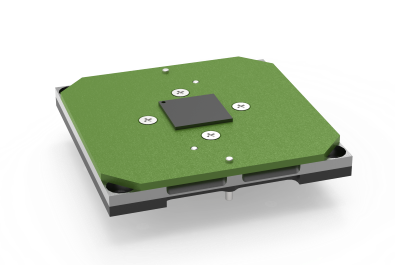
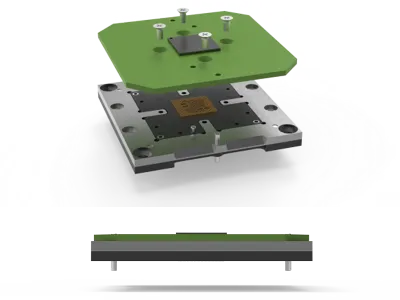
This is where the socket's design sets it apart. When the DUT is reflowed onto a coupon board and the board is mounted directly to the socket base, no lid is required to apply compression force. This leaves the area surrounding the DUT fully accessible for edge-to-edge SIL inspection, probing, or other techniques requiring this additional working space. In this configuration, nothing sits higher than the silicon.
Option 2: Low Profile Screw-Down Lids
These lids attach to the socket body with two or four screws. Their low-profile design adds only a few millimeters to the total height, making them ideal for optical inspection setups where a close working distance to the DUT is needed.
Lid Variants:
Open Top
Provides physical access to the top of the DUT. The opening is slightly smaller than the DUT footprint, allowing the lid to apply compression force while maintaining access to the die.
Closed Top:
Applies compression force across the entire surface of the DUT. This version has no cutouts and is typically used when physical access is not required during test.
Sapphire/Quartz Window:
Allows optical but not physical access to the exposed die. Often used with the conversion kit and WLCSP devices, these lids offer full-surface visibility and the optical clarity needed for emission microscopy and other advanced inspection techniques.
Already Have an RTI Socket?
Request a copy of your RTI socket drawing by submitting the form below. You must submit a drawing number or engraved socket number. Your Email domain must be associated with your company for consideration. If requesting drawings on behalf of another company, please provide contact information of someone within the socket-holder's company who can verify your affiliation and drawing request.
Request a copy of your RTI socket drawing by submitting the form below. You must submit a drawing number or engraved socket number. Your Email domain must be associated with your company for consideration. If requesting drawings on behalf of another company, please provide contact information of someone within the socket-holder's company who can verify your affiliation and drawing request.
Request Socket Drawing
Drawing Number Example
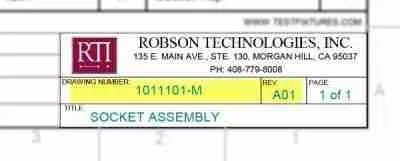
Engraved Socket Number Example
